
The Persian Sibyl is a 1647 oil on canvas painting of the Persian Sibyl by Guercino, now in the Musei Capitolini in Rome.

The Persian Sibyl is a 1647 oil on canvas painting of the Persian Sibyl by Guercino, now in the Musei Capitolini in Rome.
It was commissioned between 1645 and 1647 by Carlo Rondinelli, governor of Cento. [1] The first definite mention of it is in the painter's account book, which shows the moment of payment for it on completion - 259 lire were paid, equal to just over 64 scudi. The date was two weeks after the completion of his The Phrygian Sibyl, commissioned for Girolamo Albergati, Bologna's ambassador to Rome, now in an English private collection: [2] "On 6 June. Received from Sig. Co. Carlo Rondingelli Gov.re di Cento dopie d'Italia n. 17 1⁄2 [for] the Painting of the Persian Sibyl, which makes 259 lire - which was 64 scudi, 3 lire". [1] The artist also painted The Libyan Sibyl (Royal Collection) and The Samian Sibyl (private collection) as a pair in 1651, along with another The Samian Sibyl in 1652-1653 (Palazzo Reale, Genoa).
The work entered the Pio di Savoia collection in the mid 17th century, acquired by cardinal Carlo Francesco between 1655 and 1663, during his time as papal legate to Ferrara, Rondinelli's birthplace. [1] It was then displayed in 1697 as part of an annual display at San Salvatore in Lauro in Rome, entitled "A Sibyl by Guercino". [2] It was still in the Pio collection in a 1724 inventory before being bought with the rest of the Pio collection by Pope Benedict XIV in 1750 for the city of Rome and its new Museo del Campidoglio (now the Musei Capitolini). [1] The work then fell into obscurity for over 200 years due to several revarnishings which had deteriorated and it was even downgraded to a studio work by the brothers Cesare and Bartolomeo Gennari. [1] The true attribution was only restored after a restoration in 1990-1991 which especially improved the visibility of the signature. [2]
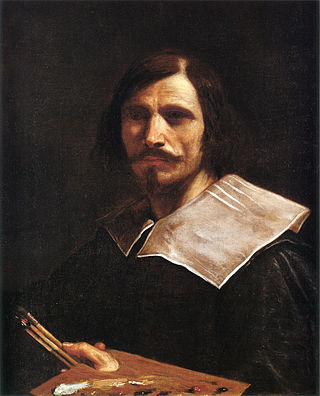
Giovanni Francesco Barbieri, better known as Guercino, or il Guercino[ɡwerˈtʃiːno], was an Italian Baroque painter and draftsman from Cento in the Emilia region, who was active in Rome and Bologna. The vigorous naturalism of his early manner contrasts with the classical equilibrium of his later works. His many drawings are noted for their luminosity and lively style.

Sant'Andrea della Valle is a minor basilica in the rione of Sant'Eustachio of the city of Rome, Italy. The basilica is the general seat for the religious order of the Theatines. It is located at Piazza Vidoni, at the intersection of Corso Vittorio Emanuele and Corso Rinascimento.
The School of Ferrara was a group of painters which flourished in the Duchy of Ferrara during the Renaissance. Ferrara was ruled by the Este family, well known for its patronage of the arts. Patronage was extended with the ascent of Ercole d'Este I in 1470, and the family continued in power till Alfonso II, Ercole's great-grandson, died without an heir in 1597. The duchy was then occupied in succession by Papal and Austrian forces. The school evolved styles of painting that appeared to blend influences from Mantua, Venice, Lombardy, Bologna, and Florence.

The Bolognese School of painting, also known as the School of Bologna, flourished between the 16th and 17th centuries in Bologna, which rivalled Florence and Rome as the center of painting in Italy. Its most important representatives include the Carracci family, including Ludovico Carracci and his two cousins, the brothers Agostino and Annibale Carracci. Later, it included other Baroque painters: Domenichino and Lanfranco, active mostly in Rome, eventually Guercino and Guido Reni, and Accademia degli Incamminati in Bologna, which was run by Lodovico Carracci. Certain artistic conventions, which over time became traditionalist, had been developed in Rome during the first decades of the 16th century. As time passed, some artists sought new approaches to their work that no longer reflected only the Roman manner. The Carracci studio sought innovation or invention, seeking new ways to break away from traditional modes of painting while continuing to look for inspiration from their literary contemporaries; the studio formulated a style that was distinguished from the recognized manners of art in their time. This style was seen as both systematic and imitative, borrowing particular motifs from the past Roman schools of art and innovating a modernistic approach.
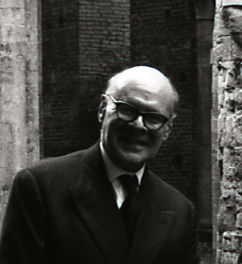
Sir John Denis Mahon, was a British collector and historian of Italian art. Considered to be one of the few art collectors who was also a respected scholar, he is generally credited, alongside Sacheverell Sitwell and Tancred Borenius, with bringing Italian pre-Baroque and Baroque painters to the attention of English-speaking audiences, reversing the critical aversion to their work that had prevailed from the time of John Ruskin.

Carlo Cesare Malvasia (1616–1693) was an Italian scholar and art historian from Bologna, best known for his biographies of Baroque artists titled Felsina pittrice, published in 1678. Together with his contemporary Giovanni Pietro Bellori, Malvasia is considered "among the best informed and most intelligent historians and critics of art who ever lived."

Giovanni Domenico Campiglia (1692–1768) was an Italian painter and engraver from Florence, active under the patronage of the House of Medici.

The collections of the Pinacoteca Comunale di Cesena, in Cesena, Italy, contain works by:
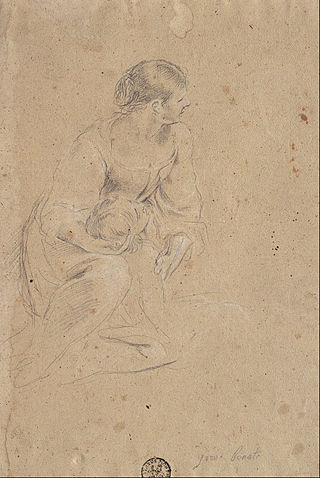
Giuseppe Bonati was an Italian painter of the Baroque period, active in Rome and Ferrara.

The Galleria Estense is an art gallery in the heart of Modena, centred around the collection of the d’Este family: rulers of Modena, Ferrara and Reggio from 1289 to 1796. Located on the top floor of the Palazzo dei Musei, on the St. Augustine square, the museum showcases a vast array of works ranging from fresco and oil painting to marble, polychrome and terracotta sculpture; musical instruments; numismatics; curios and decorative antiques.

Bartolomeo Gennari was an Italian Renaissance painter. His painting style is consistent with the Bolognese School of painting.
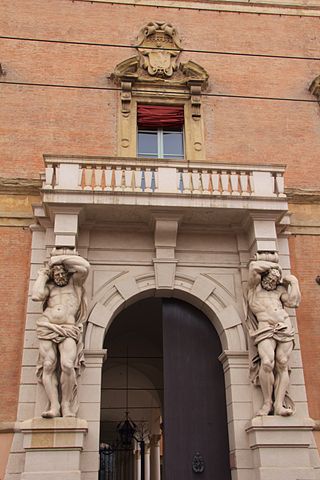
The PalazzoDavìaBargellini is a Baroque style palace located on Strada Maggiore in central Bologna, Italy. It presently hosts the Civic Museum of Industrial art and Davìa Bargellini Gallery, which is an eclectic collection of paintings as well as applied arts and functional ornamentation, described as curiosities of the old Bologna. The diverse applied art collection includes ceramics, liturgical robes, keys, ornamental door knobs, marionettes from street theaters, furniture, iron grille work, elaborately carved wooden frame, and a gilded carriage.

The Sibilla Cumana is a painting by the Italian Baroque painter Domenicho Zampieri (Domenichino) housed in the Capitoline Museum in Rome, Italy.

Annunciation is a 1646 oil on canvas painting by Guercino, now in the collegiate church of Santa Maria Maggiore in Pieve di Cento, a few kilometres from the painter's birthplace of Cento. The artist used the same colours for Mary's clothes in his 1656 Immaculate Conception, along with the face of God.

The Dying Cleopatra or The Death of Cleopatra is a c. 1648 oil on canvas painting by Guercino, now in the Palazzo Rosso in Genoa.

The Suicide of Cato is a 1641 oil on canvas painting, now in the Palazzo Rosso in Genoa.

Saint Matthew and the Angel is a 1621-1622 oil on canvas painting, produced by Guercino during his early years in Rome and now in the Musei Capitolini in Rome.
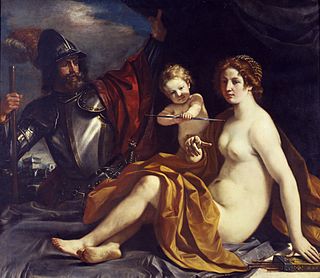
Venus, Cupid and Mars is a 1633 oil on canvas painting by Guercino, commissioned by Francesco I d'Este for his Ducal Palace of Sassuolo around 1632-1633, when the artist was in that city to paint portraits of the d'Este family. It is now in the Galleria Estense in Modena.

The Libyan Sibyl is a 1651 oil on canvas painting by Guercino. It is now in the Royal Collection, in which it was first recorded in 1790, though it had probably been purchased in Italy by Richard Dalton for George III in the early 1760s.

Saint Sebastian is a c.1615 oil on canvas painting by Guido Reni, now in the Capitoline Museums in Rome. It is one of three similar treatments of the subject produced by the artist - the others are now in the Palazzo Rosso in Genoa (c.1615) and another in the Rhode Island School of Design Museum in Providence.